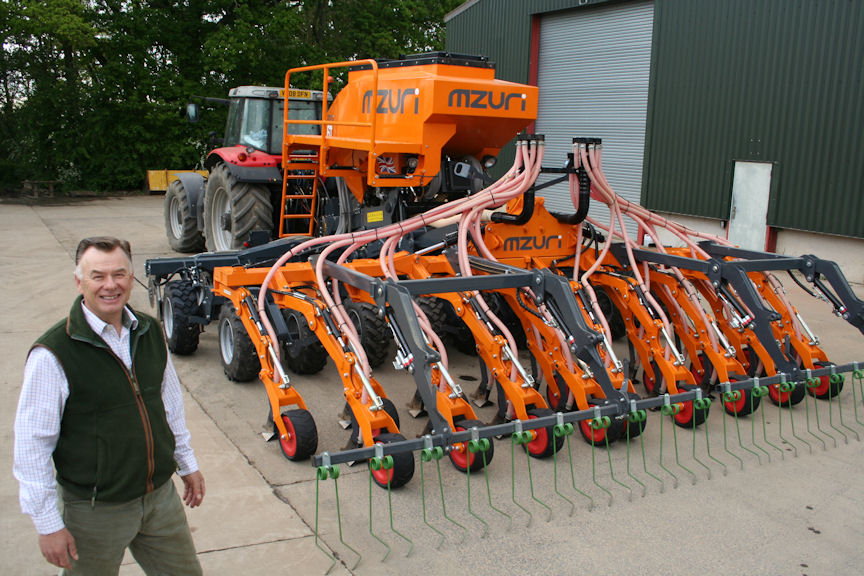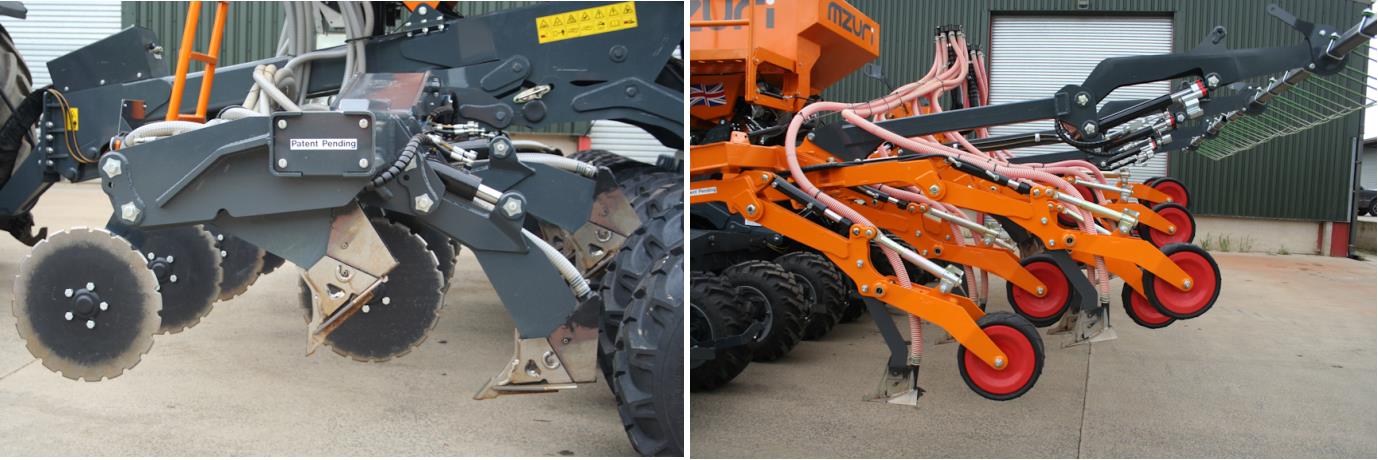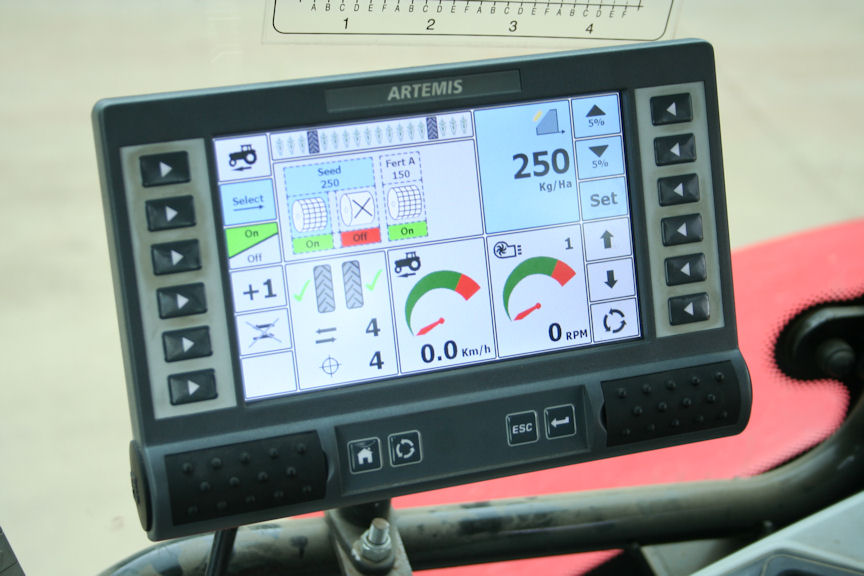
A 6m, 17-row version of the Mzuri Pro-Til strip tillage drill being unveiled at the Cereals Event will cater for larger growers wanting to exploit the performance of 300-400hp tractors for one-pass crop establishment.
Despite its wider working width and larger seed/fertiliser hopper, the Pro-Til 6T has the same layout and sequence of soil treatments successfully established by the 3m and 4m versions.
But it does introduce some new features, not least a new electronic monitoring, alarm and control system, double-acting hydraulic cylinders on the soil-loosening tines as well as the coulters, and separate storm-proof hatches for the seed and fertiliser compartments in the new hopper.
“One of the biggest challenges was to keep the central axle to maintain the successful relationship and balance between the soil loosening tines, consolidating tyres and coulter arms,” says Martin Lole of Mzuri. “We’ve achieved that, while also building in generous trash clearance, terrific strength and a folding mechanism that reduces the transport width to just 2.9m for safe, stable road travel.”

Pro-Til concept
The combination of soil working elements used on all Mzuri Pro-Til drills has proven highly successful in establishing crops in one pass with minimal soil movement to preserve beneficial soil structure and organisms across a range of soil types and conditions.
“The aim of any crop establishment technique is to create a nursery for seed to germinate as evenly and strongly as possible for easier subsequent agronomy management,” Martin Lole suggests. “That calls for a warm, moist, friable seedbed that has been re-consolidated to push out the air and achieve maximum seed-soil contact.
“The Pro-Til does this by creating strips of tilth that are clear of straw at the surface for easy sowing and to prevent nitrogen lock-up in the vicinity of the young plants,” he explains. “But the soil between the strips remains intact and well-structured, rich in oxygen, moisture, nutrients and beneficial fauna, and with residues remaining on the top.”

The 6m version of the Pro-Til offers growers with big tractors a potential 50% increase in work rate over the 4m version. But the concept is unchanged: till, consolidate and sow in quick succession with minimal soil movement and consistent working depth.
Pro-Til 6T
New features for the Pro-Til 6T include double-acting hydraulic cylinders to retract the low-draft strip cultivating tines for minimum transport width after the wings are folded 90deg; and to retract individual tines to preserve tramlines.
Each winged tine is positioned behind a trash-cutting disc and is designed to work effectively from as little as 2in deep while placing fertiliser to give crops an early feed.
Loosened soil is immediately consolidated by press wheels with uprated tyres to handle the weight of the 6T and positioned both sides of a substantial box beam axle. This two-row formation provides much greater clearance than usual to prevent soil build-up in sticky conditions, and also a stable platform for the soil loosening tines and coulters.
The two wing sections of the cross beam axle are secured in the working position by locking pins inserted and retracted by internal hydraulic cylinders. They are easily accessible for maintenance via removable end plates.
Coulter arms carried on a frame attached by hydraulic lift arms to the main chassis are unchanged from other Pro-Til drills. They can swivel sideways to dodge around large stones and eliminate stresses when drilling in a curve and come with an integral rubber depth wheel to firm the band-sown tilth and ensure good seed-to-soil contact.
Hydraulic cylinders that provide up to 250kg of down-pressure for consistent penetration are also used to retract the coulter arms on the centre-split toolbar for transport and when tramlining.
A zig-zag tine hydraulic pressure harrow brings up the rear, leaving a level, riddled finish with larger soil aggregates above finer material.
Consistent pressure on the tines, coulters and harrows is ensured by using load-sensing hydraulics: “We don’t use accumulators because they lose gas and deteriorate over time,” notes Martin Lole. “The load-sensing valve block is quite costly but does an excellent job of providing balanced, consistent pressure across these important soil-working components.”
Metering and seed/fertiliser delivery
Seed and fertiliser are measured out using interchangeable fluted rollers in Mzuri metering units with electric drive for easy calibration, half-width sowing and variable seed rates. The metering units are constructed using stainless steel and have bearings with steel balls running in an open, self-cleaning nylon casing to help keep the metering mechanism running smoothly.
Fertiliser is carried to the tines and seed to the coulters by air warmed using a heat exchanger plumbed into the hydraulic fan drive to prevent condensation in the pipes.
A 60% seed, 40% fertiliser split is standard for the 4200-litre capacity lengthways-mounted steel hopper but a removable plate in the partition enables seed-only operation. Separate openings for the seed and fertiliser sections minimise ‘cross-contamination’ risk and are capped by storm-proof steel hatches to combat the worst weather conditions.
As the hopper is filled from one side of the drill, a substantial full-length steel platform is provided on the opposite side for safe and secure access; it folds upright against the hopper as the drill is packed up for transport.
New electronic control
A new electronic control package using the latest RDS Artemis display is introduced with the new drill. It will become an option for Pro-Til 3 and Pro-Til 4 drills.
The controller display provides graphic indications for functions such as tramlining and the metering units, full-screen row blockage warnings and a combination of digital and graphic speed displays.
“The working and fan speed graphics have red sections at the end of the green line to warn operators when they are exceeding the drill’s capabilities,” notes Martin Lole. “We think it’s a more intuitive way of helping the operator achieve optimum performance.”
The working speed limit is automatically set according to seed rate calibration; and although the fan speed limit is set at the factory, it can be fine-tuned either way to account for the capabilities of the drill tractor’s hydraulic system.
One-button headland sequencing reduces the driver’s workload, lifting the drill progressively out of work at a headland and reversing the sequence when heading back into the body of the field.
Same concept, more output
While Martin Lole is understandably proud of the innovative features on the new drill he is just as proud of the way key elements of the Pro-Til concept are unchanged.
“Anyone upgrading from the Pro-Til 4T to the 6T will find it performs in exactly the same way, leaving as much straw on the surface as possible while providing a clean localised tilth for the seed and young plants,” he points out.
“The way we’ve been able to package this wider version of the drill means bigger growers can enjoy the 50% increase in work rate potential without compromising the performance and advantages of the Pro-Til concept.”
